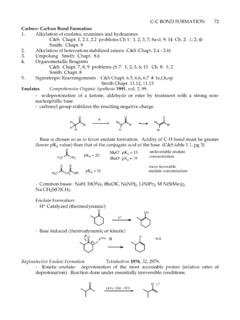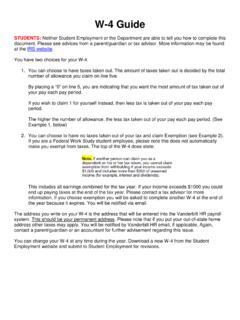Transcription of Women & Men in the 19 century: Designing Stereotypes of ...
1 Women & Men in the 19th century: Designing Stereotypes of Femininity &. Masculinity 19th Century Periods of Fashion The Empire Dress: 1790-1810. Romantic: 1815-1848 (Victoria ruled 1837-1901). Crinoline: 1840-1868 or Second Empire (rule of Napoleon III, 1852-1870). Bustle: 1868-1890. Late Victorian: 1890's= three more silhouettes! Edwardian: 1901-1910 (Edward VII). Art Movements 1780-1850: Romanticism 1848-1900: Pre-Raphaelites, Arts and Crafts, Classicists 1860-1900: Impressionists 1880-1920: Art Nouveau THE ROMANTIC PERIOD. 1815-1848. 1794: Invention of the cotton gin, increased supply of cotton which made prices drop and production soar . 1801: Joseph Marie Jacquard, a Frenchman, developed a type of mechanized loom for weaving patterned fabric.
2 Based on the draw loom, this machine provided a means for raising and lowering yarns that formed patterns automatically 1804-1815: Napoleon I Emperor of the French . 1811-1820: Regency Period in England 1820's: tailors beginning to make men's clothing that was ready made, as well as custom-made clothing 1820s: machine -loom factories in Paisley opened to produce Indian cone patterned shawls rom Kashmir and were named after the Scottish town where were crafted . 1820s-1840s: mass production of lace on textile equipment. By 1840 most handmade lace patterns could be made by machine in both narrow and wide widths, making lace trimmings and fabrics available at relatively low cost . 1820: Prince Regent becomes King George IV of England 1830: publication of first American fashion magazine, Godey's Lady's Book 1835: dye chemistry improved which revolutionized textile printing.
3 Patterned fabrics widely available 1837: Queen Victoria ascends the throne in England at the age of 18. 1839: Louis Daguerre announces that he has found a method for making photographic images 1840: wedding of Queen Victoria to Prince Albert 1846: Isaac Singer makes and patents first successful sewing machine 1848-1849: Revolution in France; decline of Romanticism Crinoline Period 1840-1868. 1850-1868: Queen Victoria continues to occupy the British throne 1850's: Levi Strauss was selling blue jeans under the "Levi's" name in California 1852: Paris opens first department store housed in one building, Le Bon Marche 1855: Mass production of steel is patented 1856: aniline or synthetic dyes produced 1857: Hoopskirt or cage crinoline is introduced 1858: Charles Frederick Worth couture establishment in Paris 1860: Charles Worth meets the Empress Eugenie and begins to design her clothes 1861: John Wanamaker's opens in Philadelphia 1861-1865: Civil War in the United States 1863: Emancipation Proclamation ends slavery in the United States 1863.
4 Ebeneezer Butterick patents the first sized, paper patterns for clothing 1867: Harper's Bazaar, fashion magazine, begins publication THE BUSTLE PERIOD AND THE. NINETIES. 1870-1900: Queen Victoria continues to occupy the throne of England 1872: Steam-powered machine for cutting multiple layers of cloth introduced 1874: Impressionist artists show their work at the Salon des Independents in Paris 1892: Vogue magazine begins publication 1880's and 1890's: Aesthetic movement in the arts; English writer Oscar Wilde lectures about Aestheticism in the United States 1890-1910: Art Nouveau style develops 1901: Queen Victoria's death; Edward VII assumes the throne; first Paris exhibit by Pablo Picasso 19th century silhouettes The influence of national features in dress in Europe had been declining since about 1675.
5 And by 1800, fashionable dress design had become international. The character of the feminine wardrobe stemmed from Paris, the masculine from London. 1680-1715 (Baroque) ; 1715-1774 (Rococo); 1775-1789 ; 1790-1799 (Directoire);. 1805(Empire); 1815-1848 (Romantic) ; 1840-1868 (Crinoline); 1868-1890 (Bustle) 1890's;. 1900-1909 (Edwardian). 19th century Male James Tissot (French 1836-1902) , The Circle of the Rue Royale Men's wear after 1800 was intended to demonstrate: The elimination of wasteful motions A rational use of resources Rejection of sensuality and individuality Behavior that was goal-directed and based on self-restraint Attire was to be: somber; austere; non-distracting Exceptions to the Rule! The 1830s Dandy Menswear: craftsmanship; impeccable fit; the essence of masculine sartorial propriety Tailoring; fit; restraint; elegance; quality Morning and frock coats; morning suit; Norfolk jacket; plus fours; sack suits A dramatic change in fashion history!
6 A mantua at the Victoria and Albert Museum, dated to 1755-1760. 1770s; 1795; 1795 Day dress, Round Gown; 1801;. 1830s; 1842; 1855 ;. 1830. Roundabout Theater Company's production of The Importance of Being Earnest at the American Airlines Theater George Beau . Brummel The Original Dandy (1778-1840). 1805. Pride and Prejudice Written by Jane Austin in 1813. The Arc of Characters .. Using fine art to design characters Mrs Grace Dalrymple Elliot, c. 1778 Lady Catherine de Bourgh Thomas Gainsborough 18th Century Fashion Silhouettes The Bennett's! Costumes and scenery working together Queen Victoria by Thomas Sully, 1838 Queen Victoria by Franz Xaver Just before coronation Winterhalter, July 1842. Queen Victoria: lived 1819-1901; ruled 1837-1901 (63 year reign).
7 Prince Albert: lived Prince Albert, Winterhalter, 1842 Queen Victoria, Sir Francis Grant, 1843. Queen Victoria Married her first cousin Albert in February of 1840. Albert died in 1961. She was 41. Went into mourning for ten years She donned clothing of widowhood and wore black for the rest of her life Gone with the Wind The American Civil War (1861 1865). Women expected to wear full mourning for two years Victorian Rules: What to wear when, minimum of seven outfits in a day (some just changed three times per day). Breakfast: pretty flowered dressing-gown 10:00AM: simple business-like tailor-made costume for shopping Return from shopping: changed into a workaday dress with apron for kitchen operations Lunch: apron/overall removed afternoon : really good dress for paying calls After calls/being polite and looking well: loose tea-gown Dinner: time to dress up Marriage Central event in the life of any woman was marriage.
8 Marriage was her accepted career. Women who remained unmarried had failed to fulfilled their destiny, both psychologically and biologically It was right to be married, it was what a woman was made for For a woman with beauty, intelligence, power of feeling, she saw herself merely as one of vast crowd of girls awaiting their promotion by marriage . With that marriage came a home, the key to happiness; without it, Women could only hope to live on as dependent's in someone else's house A good marriage allied families, reinforced caste, and upheld the morality of social norms Marriage was success; spinsterhood was failure A mill owner turned politician said the Women who have to earn their own living, instead of spending and husbanding the earnings of men, who in place of completing, sweetening, and embellishing the existence of others, are compelled to lead an independent and incomplete existence on their own.
9 Their very inability to be appendages to men left them unfinished.. Women once married took on the status of their husbands Women who married down were objects of scorn That marriage was a business for Women was often put bluntly To get ready for courtship and marriage a woman was groomed like a racehorse. In addition to being able to sing, play an instrument, and speak a little French or Italian, qualities that a young Victorian gentlewoman needed were: to be innocent, virtuous, dutiful, and ignorant of intellectual opinion Still an ideal scenario today (?). Whether married or single, all Women were expected to be weak and helpless, a fragile delicate flower incapable of making decisions beyond selecting the menu and ensuring that her many children were taught moral values A gentlewoman ensured that the home was a place of comfort for her husband and family from the stresses of Industrial Britain Woman's prime use: to bear a large family and maintain a calm atmosphere in the home where a man need not bother himself with domestic matters.
10 He assumed his house was run smoothly so he could get on with making money Men could take on mistresses, but they still expected their wives or mistresses to be faithful no matter what their misdemeanors. Charles Frederick Worth (1826-1895). Father of Haute Couture (High Dressmaking), famous 19th century fashion designer Worth, in luxurious artist attire, said A dress is the equal of a painting, 1870's . Portrait of Empress Eugenie Surrounded by Her Maids of Honor, 1856 Winterhalter He set the French Empress in a pastoral setting gathering flowers in a harmonious circle with her ladies in waiting. The painting is Winterhalter's most famous work. Worth: by 1864 responsible for all her state and evening-wear Lavish gown, typical of Worth steel cage crinoline, an invention he took credit for Elisabeth of Bavaria, Empress of Austria, 1865, Franz Xavier Winterhalter (Left) Evening dress, ca.









